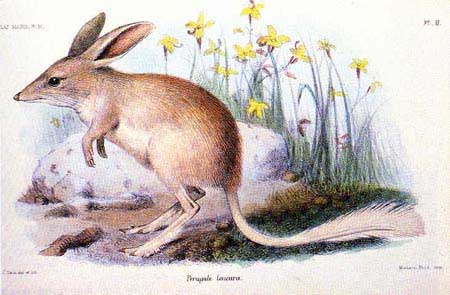Macrotis leucura (*) Cladus: Eukaryota Name Macrotis leucura (Thomas, 1887) References * Macrotis leucura on Mammal Species of the World. Vernacular names ------------ The Lesser Bilby (Macrotis leucura), also known as the Yallara, the Lesser Rabbit-eared Bandicoot or the White-tailed Rabbit-eared Bandicoot, was a rabbit-like marsupial. Reaching the size of a young rabbit, it lived in the deserts of Central Australia. Since the 1950s, it has been believed to be extinct. The Lesser Bilby was first discovered in 1887. An omnivore, its diet included termites, ants and roots.[2] It was grey-brown, fading to pale grey underneath with a white tail, and much smaller than the Greater Bilby at around 300 to 450 g. It is known only from the Gibson and Great Sandy deserts of arid central Australia; it may have had a greater range but this must remain unknown. It was exterminated by fur trapping, fox predation, and competition from rabbits. It burrowed in sand dunes, constructing burrows 2-3 metres deep and closing the entrance with loose sand by day. It was nocturnal and bred seasonally, giving birth to twins. There seems to have been several in Cooncherie Station in the summer of 1932, but these were the last to be collected alive. The last specimen was a skull picked up below a Wedge-tailed Eagle's nest in 1967. The bones were estimated at being under 15 years old. References 1. ^ Burbidge, A., Johnson, K. & Dickman, C. (2008). Macrotis leucura. In: IUCN 2008. IUCN Red List of Threatened Species. Downloaded on 28 December 2008. Database entry includes justification for why this species is listed as extinct * Tim Flannery and Peter Schouten A Gap in Nature. Published by William Heinemann (2001) Source: Wikispecies, Wikipedia: All text is available under the terms of the GNU Free Documentation License |
|

